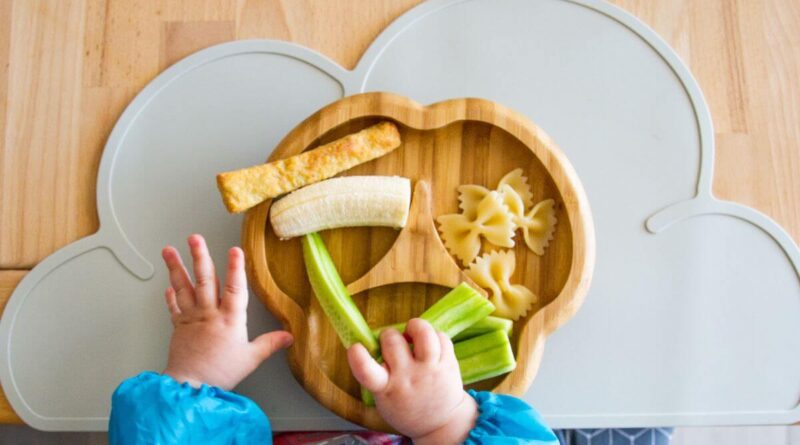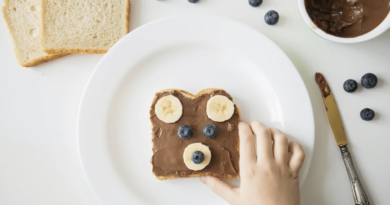20 Wholesome and Nutritious Baby Led Weaning Vegan Foods For Your Little Ones’s Optimal Health
Let’s start by addressing that it’s totally OK to start solids with baby led weaning vegan foods.
In recent years, with the rise of veganism there has been a mix of opinions and concerns about vegan babies, but there is no reason why your child’s health will suffer as long as their diet is carefully planned.
Here are some of the common misconceptions and benefits of a vegan diet for babies.
This blog contains affiliate links

Common Concerns and Misconceptions:
- Nutritional Adequacy: One of the primary concerns is whether a vegan diet can provide all the essential nutrients for a growing baby. With careful planning and knowledge, a vegan diet can be nutritionally adequate. Foods like fortified cereals, legumes, and vegan baby food recipes rich in iron, calcium, and omega-3s can provide many of the essential nutrients but a multivitamin to provide the more tricky nutrients is often needed to supplement the diet.
- Protein Sources: Many wonder if plant-based diets offer enough protein for babies. The truth is, legumes, whole grains, and soy products like tofu can provide ample protein for your little one.
- Growth and Development: Some believe that vegan babies might lag in growth. However, when a vegan diet is well-planned and diverse, babies can achieve regular growth milestones just like their non-vegan counterparts.
- Dairy Alternatives: The misconception that dairy is needed for calcium and other nutrients is widespread. As long as the missing nutrients are being provided from alternative sources, cow’s milk isn’t necessary
Benefits of a Vegan Diet for Babies:
- Digestive Health: Plant-based diets are rich in fibre, which can promote healthy digestion and prevent constipation, a common concern in babies starting solids.
- Ethical and Environmental Benefits: Raising a vegan baby aligns with many parents’ ethical beliefs, teaching children compassion and care for all living beings. Additionally, a plant-based diet has a lower environmental footprint, contributing to a more sustainable future for our little ones.
- Lower Risk of Certain Diseases: Plant-based diets can lead to a lower risk of obesity, heart diseases, and certain types of cancers later in life.
While raising a vegan baby does require careful planning and a bit of extra knowledge, it’s entirely feasible as well as being beneficial, but I highly recommend consulting with a registered dietitian who specialises in paediatric nutrition can offer guidance and peace of mind to parents

What is baby led weaning?
Baby-led weaning (BLW) is introducing solids where your baby self-feeds with finger foods instead of traditional purées.
Finger foods need to be developmentally appropriate to reduce the risk of choking and ensure a balanced nutrient intake.

Vegan baby nutrition
Raising a baby on baby led weaning vegan foods requires a bit more planning to ensure they receive all the essential nutrients for healthy growth and development.
These are the nutrients that parents should pay special attention to:
- Iron: Crucial for cognitive development as iron helps red blood cells carry oxygen to the brain. Vegan sources include fortified cereals, legumes such as beans, lentils and chickpeas, and dark green leafy vegetables. Pairing iron-rich foods with vitamin C sources, like fruits and vegetables, will enhance it’s absorption.
- Zinc: Essential for growth and immune function. Found in whole grains, legumes like beans, lentils and chickpeas, and nuts.
- Vitamin D: Important for bone health. While sunlight is a natural source, in the northern hemisphere we don’t get enough and therefore a 10mcg vitamin D supplement is necessary whether your baby is vegan or not.
- Vitamin A: Crucial for vision and immune function. Vegan sources include orange and yellow vegetables like carrots and sweet potatoes.
- Vitamin C: Enhances iron absorption and supports immune function. Found in fruits like oranges, strawberries, and kiwi but also vegetables such as potatoes and tomatoes.
- Iodine: Important for thyroid function. Seaweed is a good source, but not recommended for children as it can have too much iodine! Often I will recommend a supplement or foods fortified with iodine as it’s difficult to get in the diet from natural vegan sources.
- Vitamin B12: Essential for nerve function. As it’s not naturally found in plant-based foods, vitamin B12 fortified foods or supplements are needed.
- DHA: An omega-3 fatty acid vital for brain development. Algal oil supplements are a vegan source.
Nutrients Parents Often Worry About But Are Easier to find:
- Protein: While many worry about protein intake, many baby led weaning vegan foods are rich in protein. Legumes like beans and pulses, tofu, and tempeh are all protein sources but other foods also contain protein even if you don’t think of them as traditional protein sources such as bread, grains, nuts and seeds.
- Calcium: Essential for bone health. Vegan sources include fortified plant-based milks (added to food, not as a main drink), green leafy vegetables, tahini, and almonds.

Baby led weaning vegan meal planning
Crafting a meal plan for your vegan baby requires a focus on essential nutrients, particularly iron1, vitamin C, and energy sources. If you focus on these nutrients, your baby will usually get the other nutrients along the way!
Here is how to do this:
1. Prioritise Iron-Rich baby led weaning vegan Foods:
Because iron is crucial for babies brain development start with iron rich baby led weaning vegan foods first when planning your baby’s meals. Vegan sources of iron include:
- Legumes: Lentils, chickpeas, and beans can be mashed or served as soft-cooked whole pieces.
- Whole Grains: Quinoa and fortified cereals are excellent choices.
- Green Leafy Vegetables: Spinach and kale can be steamed and mashed or incorporated into soups.
2. Boost Iron Absorption with Vitamin C:
Next consider the vitamin C source. Pairing iron-rich foods with vitamin C enhances iron absorption, making it more available for the body.
- Fruits: Citrus fruits, strawberries, kiwi, and bell peppers are high in vitamin C. These can be offered as finger foods or purees.
- Vegetables: Broccoli and Brussels sprouts are not only rich in vitamin C but also contain iron.
3. Ensure Adequate Energy Sources:
Finally make sure you have a good energy provider. Babies have high energy needs relative to their size. You need to include energy-dense baby led weaning vegan foods to ensure they get the calories they need for growth and activity.
- Healthy Fats: Avocado can be sliced or mashed. Chia seeds can be incorporated into puddings or smoothies.
- Starchy Carbohydrates: Sweet potatoes, butternut squash, and oats provide sustained energy. These can be offered as soft-cooked pieces or porridges.
- Nuts and Seeds: Nut butters, like almond or peanut butter, can be thinly spread on toast or mixed into porridges.
If you feel like you’re not sure if they’re getting the right mix of nutrients, seek the advice of a paediatric dietitian.

How to introduce allergens to a vegan baby
This is a common question as some of the allergens such as egg, milk and fish are not vegan foods.
Current advice is to introduce all of the common allergens to babies before their first birthday to reduce allergy risks. There isn’t a separate recommendation for vegan families.
Some vegan families, especially if their baby is at higher allergy risk, opt to introduce non-vegan allergens for future protection. If you do decide to do this, these non vegan allergens should be a regular part of the baby’s diet to maintain protection.
Timely Introduction:
Start introducing allergenic foods around 6 months, but not before 4 months. For baby-led weaning, ensure your baby can handle food chunks, making a start closer to 6 months ideal.
One Allergen at a Time:
Introduce allergens individually, waiting a few days between each to identify potential reactions.
Common Vegan Allergens:
- Celery
- Gluten-containing cereals
- Lupin
- Mustard
- Nuts
- Peanuts
- Sesame seeds
- Soya
- Sulphur dioxide
Monitor for Reactions:
Watch for signs like skin rashes, vomiting, or unusual fussiness post-introduction. If symptoms arise, seek medical counsel.
Consistency:
Once an allergen is well-tolerated, continue including it in your baby’s diet to maintain their tolerance.
Expert Consultation:
For babies with a family history of allergies or eczema, consult a paediatrician or allergy specialist dietitian before introducing high-risk allergens.

Should soya be limited in a baby’s diet?
Soya, a staple food when you are vegan as it offers protein and essential nutrients. However, its role in a baby’s diet often raises questions. Here’s a brief overview:
- Nutritional Benefits: Soya is a protein and also provides iron, calcium, and omega-3s. Foods like tofu, tempeh, and fortified soy milk are beneficial for babies.
- Phytoestrogens Concern: While soya contains phytoestrogens, which resemble oestrogen, moderate consumption is generally considered safe in babies over 6 months of age
- Allergies: Soya however is a common allergen. Introduce it following the guidance above.
- Diversity in Diet: While soya is nutritious, it’s actually healthier to eat a variety of different protein sources like beans, pulses, grains, and nuts for a more nutritious diet.
- Choose Whole Soy: Opt for whole soy foods like tofu over highly processed variants such as soya meat alternatives for maximum benefits.
Is soya milk ok?
Soya milk should not be offered as a main drink to babies under one year old.
Before their first birthday, babies’ should only be drinking breast milk or infant formula, alongside small amounts of water.
After one year, soya milk can be introduced as part of a balanced diet, but it’s important to choose one which complements your toddler’s diet.
When you’re making your baby’s meals, using breast milk or infant formula is the most nutritious choice however you can use soya milk instead.

What are some first foods for baby led weaning vegan babies?
If you think about it, most first weaning foods are vegan as the recommendations are to start with a vegetables first approach. Here are some vegan-first finger foods to explore:
1. Vegetables:
- Sweet Potato: Soft-cooked sweet potato sticks are not only easy for little hands to grasp but are also rich in vitamin A and fibre. They’re also a great energy provider. Cut into 5 cm battens before cooking so that they are the perfect size for little hands.
- Butternut Squash: Soft, roasted cubes of butternut squash are another excellent choice, offering a naturally sweet flavour that babies often love. Ensure your cubes are big enough for little fists to pick up.
- Broccoli: Steamed broccoli florets provide iron and come with a natural built in handle, making it easy for babies to explore.
2. Fruits:
- Banana: Sliced lengthways or chopped into chunks, bananas are soft and easy to gum and are a good source of potassium and vitamin B6.
- Avocado: Offer this creamy fruit, rich in healthy fats and a great energy provider for growth, as slices or spread on a piece of toast.
- Pear: Soft-cooked or ripe pears sliced lengthways (core removed) are gentle on a baby’s gums and provide essential vitamins and fibre.
3. Grains and Cereals:
- Oats: Make up a batch of oat fingers, from a mixture of oats, fortified plant-based milk such as soya milk, and mashed fruits.
- Quinoa: Soft-cooked quinoa patties are protein-rich and introduce a new texture to your baby.
4. Legumes and Pulses:
- Lentils: Make lentil patties in the shape of burgers or sausages for a finger food that is an excellent source of protein and iron.
- Chickpeas: Blend chickpeas together with tahini (allergen) olive oil, and herbs and spices to make a baby friendly hummus offering both protein and essential minerals. Your baby might enjoy it spread on toast
5. Other Vegan Options:
- Tofu: Soft-cooked tofu cubes are a versatile option, providing calcium and protein. Lightly season or marinate them with herbs and spices to add flavour.
- Nut Butters: Spread smooth nut butters, such as almond or peanut butter, on bread or toast for a perfect treat. Choose those with no added sugars or salt.

Should your vegan baby take a multivitamin?
In the UK, experts recommend that children between 6 months and 5 years of age take supplements for Vitamins A, C and D, unless they consume more than 500ml of infant formula daily.
For vegan babies, this recommendation is the same but there are a few extra nutrients that I would recommend considering supplementing alongside this.
You should supplement vitamin B12 and iodine in a vegan diet to ensure your little one receives a reliable source, as they are not sufficiently available through vegan foods alone.
Vegans typically have minimal intake of DHA fats from natural sources. Supplementation with EPA and DHA from microalgae is essential given the significance of omega-3 fats in brain health.
Keep in mind that infant formula already includes a multivitamin. Before introducing an additional supplement to your baby’s diet, it’s crucial to check with a paediatric dietitian because it is possible to have too much!

Can you get vegan baby formula?
In the UK, a 100% vegan baby formula isn’t available. Even the soy-based formulas contain animal-derived ingredients.
Currently, SMA Soya is the only soy-based formula available in the UK, and it is not recommended for babies under 6 months old.
SMA Soya sources its vitamin D from lanolin derived from the wool of living sheep.
Although many formulas contain omega-3 fatty acid DHA from animal sources, SMA Soya opts for a plant-based approach by utilizing algae (seaweed) and fungi (mushrooms) instead.

20 baby led weaning vegan Recipes
Discover our top 20 baby-led weaning recipes that pack nutrition and flavor, perfectly crafted for little hands.
Warm vegan blw breakfasts
- Quinoa Porridge Quinoa porridge is a warm option that’s rich in protein and iron, essential for your baby’s growth. The soft texture is perfect for babies learning to eat on their own.
- Banana oat pancakes These pancakes naturally sweeten with banana and contain no added sugar, offering a healthy, energy-packed breakfast or snack.
- Sheet pancake Cut a single-sheet pancake into strips to make it easy for babies to handle and munch on, providing a versatile base for various toppings.
Nutritious Meals for vegan baby led weaning
- Sweet potato and black bean bites Sweet potatoes provide vitamins while black beans add fibre and iron. Together, they make a delicious and wholesome finger food.
- Lentil spaghetti bolognese Lentils are an excellent iron source, and when served with spaghetti, they make for an easy-to-eat dish that encourages babies to practise their pincer grip.
- Mini chickpea flour frittata (omit the salt) These frittatas are a great way to introduce a variety of vegetables and are rich in protein from the chickpea flour, making them a satisfying meal.
- Zucchini pasta: Introducing courgette, or zucchini, pasta is an enjoyable and clever method to incorporate more vegetables into your baby’s diet. Courgette is also packed with essential vitamins that are beneficial for growth and development.
- Tofu and broccoli stir fry. (omit sugar and salt) This dish is a powerhouse of nutrients, offering protein from tofu and a host of vitamins from broccoli, all in a baby-friendly form.
- Vegan omelette Made with chickpea flour, a vegan omelette is a different way to provide a protein source that’s also rich in iron.
- Vegetable lentil loaf This loaf is a hearty source of iron and protein, and the texture is ideal for babies who are mastering the art of chewing.
- Tahini mac n cheese Tahini gives a creamy texture and a calcium boost, while the pasta shapes are perfect for little fingers to pick up and self-feed.
Creative finger foods
- Sweet potato wedges with avocado dip Sweet potatoes are high in vitamin A, and when served with an avocado dip, they provide healthy fats necessary for brain development.
- Chickpea pancakes. These savory pancakes offer a dual benefit; they are not only rich in protein but also high in fiber, thereby providing a hearty option for babies eager to discover new textures.
- Baby falafels You can easily make falafels into a tasty finger food that’s rich in protein and fiber. Shape them into finger-friendly sizes perfect for baby-led weaning.
- Hummus with pitta and fruit Hummus is a great source of plant-based protein and healthy fats, and when paired with soft pitta and fruit, it’s a balanced meal.
- Porridge fingers These are easy to hold and chew, providing a good source of fibre and healthy fats. The raspberries add a burst of vitamin C, aiding iron absorption from the oats. They’re also a great way to use up leftover porridge!
- Baked seasoned tofu nuggets Tofu is a complete protein and these nuggets are a fun way for babies to enjoy it. They’re also easy to grasp and can help develop fine motor skills.
- Bean and beetroot patties Packed with protein and the goodness of beetroot, these patties are not only nutritious but also visually appealing to babies, encouraging them to explore new foods.
- Polenta bites (omit the salt) These bites are soft yet hold their shape, making them ideal for little hands. Polenta provides a good source of energy and pairs well with a variety of flavors.
- Quinoa and veggie balls (omit the salt) These balls combine the protein-rich quinoa with veggies for a nutrient-dense meal. Make them into finger shapes for babies to easily pick up and self-feed.

The post 20 Wholesome and Nutritious Baby Led Weaning Vegan Foods For Your Little Ones’s Optimal Health appeared first on The Children's Nutritionist.




